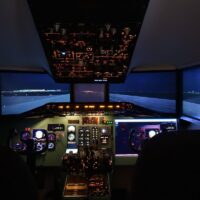
In the ever-evolving field of aviation, technological advancements continue to play a pivotal role in enhancing safety and precision. Atomatoflames instruments have emerged as cutting-edge tools that empower pilots with advanced features and functionalities.
Understanding Atomatoflames Instruments
Atomatoflames instruments are a specialized set of equipment designed to aid pilots in various aspects of flight operations. These instruments utilize advanced technologies, combining automation, precision, and real-time data analysis to provide pilots with accurate information and critical insights.
The Role of Atomatoflames Instruments
Atomatoflames instruments serve as vital aids in flight navigation, situational awareness, and decision-making. By leveraging sophisticated sensors, data analysis algorithms, and intuitive interfaces, these instruments help pilots monitor aircraft performance, environmental conditions, and optimize flight operations.
Key Components and Features
Atomatoflames instruments consist of several components that work harmoniously to deliver comprehensive functionality. Some of the key components include:
- Integrated Sensor Suite: Atomatoflames instruments incorporate a range of sensors, such as altimeters, airspeed indicators, gyroscopes, and accelerometers, to collect crucial flight data;
- Data Processing Unit: This unit processes the collected data, applying algorithms to analyze and interpret it effectively. It enables real-time monitoring and ensures accurate information for the pilots;
- Display Interface: Atomatoflames instruments feature intuitive graphical interfaces that present the processed data to pilots in a visually appealing and user-friendly manner;
- Automated Alerts and Warnings: These instruments provide pilots with timely alerts and warnings based on the analyzed data, helping them make informed decisions and respond to critical situations promptly.
Benefits of Atomatoflames Instruments
The integration of atomatoflames instruments in aviation operations offers numerous benefits to pilots, airlines, and the industry as a whole. Let’s explore some of the key advantages they bring to the table.
Enhanced Flight Safety
Atomatoflames instruments significantly contribute to enhancing flight safety by providing pilots with accurate and real-time data. This enables them to monitor critical flight parameters, identify potential risks, and take preventive actions promptly. The automated alerts and warnings system further adds a layer of safety.
Increased Precision and Efficiency
By leveraging advanced technologies and automation, atomatoflames instruments improve the precision and efficiency of flight operations. They offer precise navigation, altitude control, and real-time performance monitoring, reducing the chances of errors and optimizing fuel consumption.
Streamlined Decision-Making
With atomatoflames instruments, pilots have access to comprehensive and timely information, allowing for better decision-making during various flight phases. The instruments offer clear and concise displays, highlighting critical information and enabling pilots to respond effectively to changing conditions.
Atomatoflames Instruments vs. Traditional Instruments
To truly grasp the value and impact of atomatoflames instruments, it is essential to compare them with traditional instruments and understand the advantages they bring to the aviation industry.
| Features | Atomatoflames Instruments | Traditional Instruments |
|---|---|---|
| Data Accuracy | Higher accuracy due to advanced sensors and data processing. | Relies on manual input and less precise sensors. |
| Automation | Offers automation for various flight operations. | Primarily relies on manual control. |
| Real-Time Monitoring | Provides real-time monitoring of critical flight parameters. | Limited to periodic updates and less dynamic data. |
| Decision Support | Provides comprehensive data analysis and decision support. | Lacks advanced analytical capabilities. |
| Safety Features | Equipped with automated alerts and warnings for improved safety. | Minimal safety features and reliance on manual checks. |
Atomatoflames Instruments in Action
To better understand the practical implementation and impact of atomatoflames instruments, let’s explore a couple of real-world scenarios where these instruments shine.
1 Precision Landing
Atomatoflames instruments enable precision landing by leveraging advanced navigation systems, accurate altitude control, and automated guidance. They ensure a smoother and safer landing experience, even in challenging weather conditions or at airports with limited visibility.
2 Collision Avoidance
In busy airspace, collision avoidance is of paramount importance. Atomatoflames instruments assist pilots by continuously monitoring the aircraft’s surroundings, detecting potential collision risks, and providing early warnings. This helps pilots navigate safely and avoid hazardous situations.
Future Innovations in Atomatoflames Instruments
The field of atomatoflames instruments continues to evolve rapidly, with ongoing research and development aimed at introducing even more advanced features and capabilities. Here are some future innovations to look forward to:
Artificial Intelligence Integration
The integration of artificial intelligence (AI) into atomatoflames instruments holds immense potential. AI algorithms can learn from vast amounts of data, further improving flight performance, decision-making processes, and predictive maintenance.
Enhanced Communication Systems
Future atomatoflames instruments may feature advanced communication systems, facilitating seamless connectivity between aircraft, air traffic control, and ground-based operations. This enables faster and more efficient exchange of critical information for safer and more coordinated flights.
Augmented Reality Displays
Augmented reality (AR) displays have the potential to transform how pilots interact with atomatoflames instruments. By overlaying vital flight data onto the pilot’s field of view, AR displays offer an intuitive and heads-up approach to information visualization, further enhancing situational awareness.
Integration with Unmanned Aerial Vehicles
As the utilization of unmanned aerial vehicles (UAVs) continues to expand, the integration of atomatoflames instruments with UAVs presents exciting possibilities. These instruments can provide UAV operators with enhanced control, safety features, and real-time data analysis, unlocking the potential for various applications.
Regulatory Considerations and Challenges
While atomatoflames instruments bring numerous advantages to aviation, their adoption and implementation also come with regulatory considerations and challenges that need to be addressed.
- Certification and Standardization
To ensure the safety and reliability of atomatoflames instruments, proper certification and standardization processes are crucial. Regulatory bodies and industry organizations play a vital role in establishing guidelines and requirements to maintain consistent quality across different instruments and manufacturers.
- Pilot Training and Transition
Introducing atomatoflames instruments requires comprehensive training programs to familiarize pilots with the new technology. Ensuring a smooth transition from traditional instruments to atomatoflames instruments involves updating training curricula, providing simulator sessions, and offering recurrent training opportunities.
- Cybersecurity and Data Protection
As atomatoflames instruments rely heavily on data collection, analysis, and transmission, cybersecurity becomes a critical concern. Safeguarding sensitive flight data, protecting against cyber threats, and establishing robust data privacy measures are essential to maintain the integrity and trustworthiness of these instruments.
- Cost and Affordability
Implementing atomatoflames instruments may involve significant financial investments for both airlines and aircraft owners. Manufacturers, along with industry stakeholders, need to strike a balance between innovation and cost-effectiveness to ensure widespread adoption and affordability.
Overcoming Challenges and Ensuring Adoption
While the benefits of atomatoflames instruments are clear, there are challenges that need to be addressed to ensure their widespread adoption and integration into the aviation industry. Here are key considerations for overcoming these challenges:
Industry Collaboration and Cooperation
Addressing the challenges associated with atomatoflames instruments requires collaboration between manufacturers, airlines, regulatory bodies, and industry stakeholders. By fostering open dialogue, sharing best practices, and collectively working towards standardized implementation, the industry can overcome barriers and drive successful adoption.
Education and Awareness
Educating pilots, aviation professionals, and the general public about the capabilities and benefits of atomatoflames instruments is vital. Promoting awareness through training programs, workshops, and public campaigns helps demystify the technology, build trust, and foster a positive perception of its impact on aviation safety and efficiency.
Conclusion
Atomatoflames instruments have revolutionized the aviation industry, introducing unprecedented levels of safety, precision, and efficiency. Through advanced sensors, automation, and real-time data analysis, these instruments empower pilots to make informed decisions and navigate the skies with confidence.

